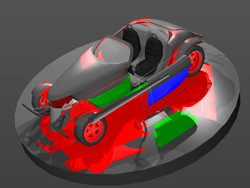Abstract

We have developed an approach for improving the performance of object manipulation in ray tracing systems. We assume that users alternate between navigating the scene and manipulating objects in the scene. We divide the scene in objects currently manipulated by the user and the non-interactive rest. Once a user stops navigating, we compute and store the first order reflections for the non-interactive objects. In a composition step only the manipulated objects need to be fully ray traced, while the stored reflections of the rest of the scene have to be tested only against the manipulated objects. In an initial evaluation we found that this approach significantly improves frame rates during object manipulation---and thus increases interaction performance.
Our approach directly extends to refraction and shadow rays. It could also be used for further ray generations beyond the first order effects, but the speedup would strongly depend on the actual scene and it would probably be less significant. Our approach is independent of the underlying spatial data structure and it neither reduces visual quality nor does it introduce visual artifacts---within its constraints.
Publication
Kurz, D., Lux, C., Springer, J. P., Fröhlich, B.
Improving Interaction Performance for Ray Tracing
Accepted for the Eurographics 2008 Conference.
[preprint][poster at EG2008]
